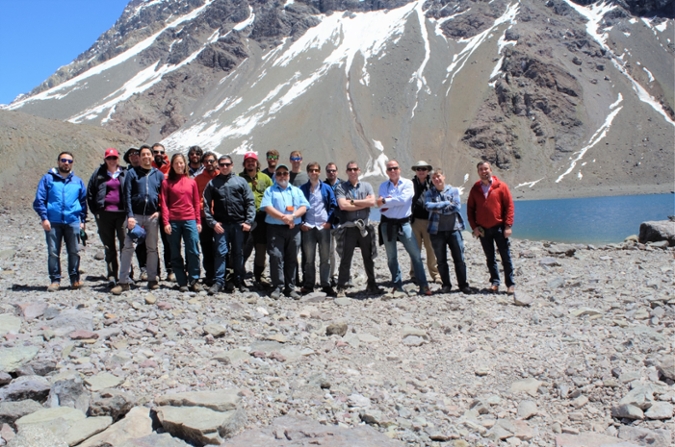
Recent INARCH Activities and the 4th INARCH Workshop
Santiago and Portillo, Chile 24-26 October 2018
By John W. Pomeroy, James McPhee, and Chris DeBeerINARCH and Its Recent Activities
The International Network for Alpine Research Catchment Hydrology (INARCH) is a crosscutting project of the GEWEX Hydroclimatology Panel (GHP) with the objectives to better understand alpine cold regions hydrological processes, improve their prediction, diagnose their sensitivities to global change, and find consistent measurement strategies. INARCH is formulated around addressing five core questions: (1) How do varying mountain measurement standards affect scientific findings around the world? (2) What control does changing atmospheric dynamics have on the predictability, uncertainty, and sensitivity of alpine catchment energy and water exchanges? (3) What improvements to alpine energy and water exchange predictability are possible through improved physics, downscaling, data collection, and assimilation in models? (4) Do existing mountain model routines have global validity? and (5) How do transient changes in perennial snowpacks, glaciers, ground frost, soil stability, and vegetation impact alpine water and energy models?
In just three years, INARCH has made exceptional progress towards addressing these questions and achieving its goals. This year, the team has grown with the inclusion of new members and research sites in Norway, Russia, Spain, and the USA. Moving forward, INARCH will be developing synthesis papers and other products as outputs of the network and contributing to initiatives beyond GEWEX, such as Future Earth, the World Meteorological Organization (WMO), the Intergovernmental Panel on Climate Change (IPCC), the United Nations Educational, Scientific, and Cultural Organization (UNESCO)’s International Hydrological Programme (IHP), and the United Nations at large through its International Water Action Decade: Water for Sustainable Development, 2018–2028.
Over the past year, there have been several notable areas of activity and progress. John Pomeroy (Canada) and Danny Marks (USA) served as guest editors for an INARCH special issue of Earth System Science Data (ESSD), covering Hydrometeorological data from mountain and alpine research catchments. The aims of the issue and links to published and in-discussion papers can be found at https:// www.earth-syst-sci-data.net/special_issue871.html. The issue closed on 30 September 2018, and 19 papers were contributed from around the world, with several more coming into the discussion phase; however, new papers that contribute to this special issue are still welcome by ESSD and will be handled by the special editors if the contributing authors request it.
INARCH convened a special session on Observing and modeling the mountain water cycle using alpine research catchments at the GEWEX Open Science Conference held in Canmore, Alberta, Canada, on 7–10 May, 2018. It addressed topics on: a) convection permitting modeling and high resolution satellite data, b) use of big data techniques and large computers and models, c) hybrid downscaling techniques [e.g., such as the Intermediate Complexity Atmospheric Research (ICAR) model], d) other observational datasets, and e) recent completed field efforts [such as the WMO Solid Precipitation Intercomparison Experiment (SPICE) project on measurement of snow]. The session included eight oral presentations and 11 poster presentations. Dr. John Pomeroy and Dr. Chris DeBeer (Canada) were local organizers for the GEWEX Conference, and Dr. Pomeroy and Bob Sandford also led a tour group to the hydrological apex of the Rocky Mountains: the Columbia Icefield in Banff National Park. Full details on the conference are found at http://www.gewexevents.org/events/2018conference/.
The second GEWEX Convection-Permitting Climate Modeling Workshop was held at the National Center for Atmospheric Research (NCAR) Mesa Lab in Boulder, Colorado, USA on 4–6 September, 2018. The meeting was hosted by Roy Rasmussen (USA) and focused on scientific and technical challenges related to convection-permitting climate modeling (horizontal grid spacing ≤4 km). These challenges include model setup, observational datasets, evaluation techniques, computational resources, model intercomparisons, and the use of convection-permitting simulations in impact research. The 3-day workshop's aim was to foster collaborations and synergies to work on this challenging topic as a community, one that includes INARCH. There were oral and poster sessions, several invited talks on key topics, and multiple opportunities for discussions and networking. More information, including an agenda and presentations, can be found at https://ral.ucar.edu/events/2018/cpcm.
Read more about INARCH workshop vvisit the 4th INARCH Workshop Article.
